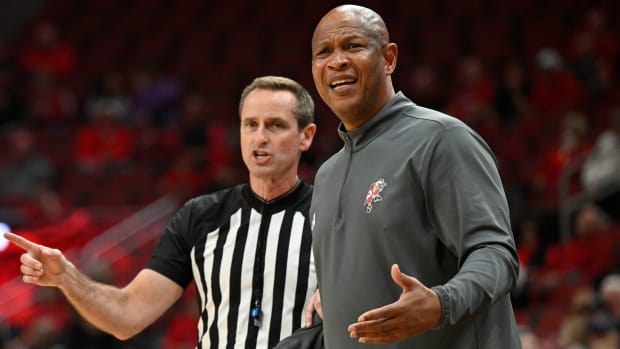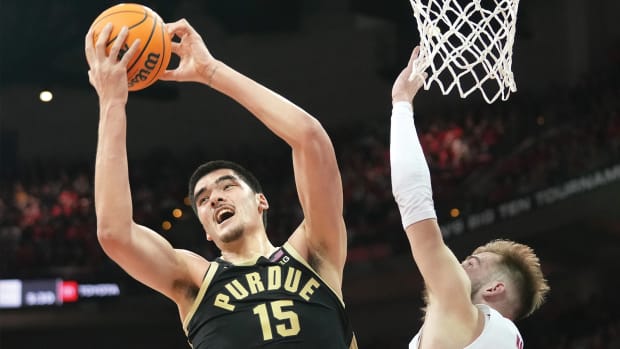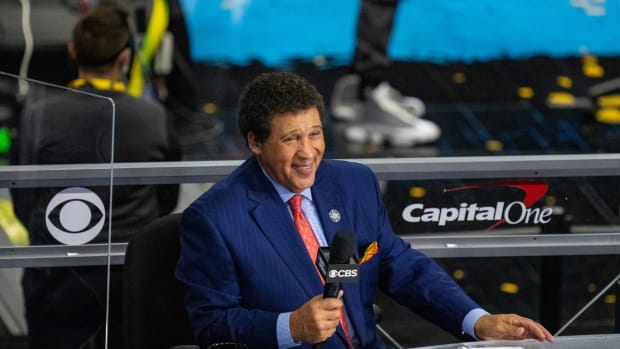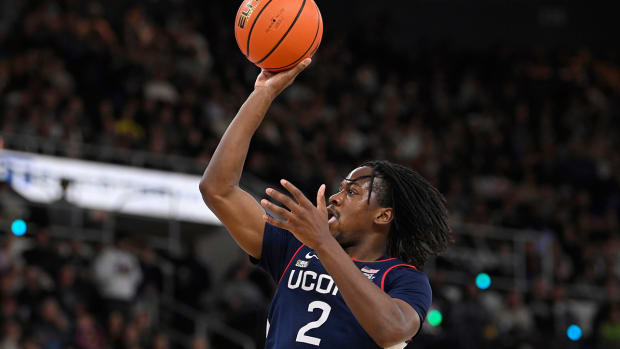'There’s a Lot of Pain and Uncertainty': The Gloomy Impact of the Pandemic on Sports Broadcasting
The soothing voice booming through Madison Square Garden belonged to Mike Watts. The 27-year-old broadcaster and public address announcer delivered the bad news to a small crowd during halftime of the Big East tournament quarterfinal between St. John’s and Creighton: the game would not resume. The nation’s last live major sporting event was canceled.
In a way, Watts’s voice brought to an end major American sports, the curtain call on action before the coronavirus pandemic triggered a three-month shutdown. Fortuitously, Watts will be there when the curtain rises. He’s scheduled to handle the international play-by-play broadcast when the Portland Thorns play the North Carolina Courage on Saturday to begin the National Women’s Soccer League’s truncated season—a month-long tournament in Utah. The match marks the first major American team competition since the mid-game cancellation of that Big East game on March 12.
In between the two events, 107 days have passed. Naturally, Watts is a ball of nerves. “It’s kind of funny,” he says, “I don’t know how my voice will sound. There is a nervousness about coming back.”
Watts is one of the lucky ones. He’s heading back to work much sooner than many of his colleagues. The virus’s tentacles have choked virtually every industry in college sports, and that includes the voices on your radio and faces on your television.
Broadcasters, hundreds of them, are out of work. Freelance television crews, some that lost upwards of 70 events, are dipping into their retirement savings, and dozens of school radio play-by-play announcers are furloughed until at least the end of the summer. For many other high-profile TV broadcasters, their multi-year contracts, structured to span a school year, are coming up for renegotiation at a time of economic distress.
All of them are fretting about the uncertain future of an industry that, pre-pandemic, was experiencing its golden years—conference networks and digital avenues providing bountiful opportunities. They’re worried about the younger broadcasting generation—college graduates now entering an uneasy field. “I think the sports broadcasting world is in danger of losing some very talented people,” says Tom Hart, one of ESPN’s play-by-play announcers for college football and college baseball. “I have a positive outlook that we’re going to have a college football season, but I think it’s going to look different than any other season we’ve ever seen. Get comfortable being uncomfortable.”
Announcers like Hart are imagining what a broadcasting booth might look like. Can you wear a mask and call a game properly? And who really expects to adhere to social distancing in a TV truck? TV producers are expecting a significant increase in remote broadcasts, a way to avoid travel, saving on costs and limiting health risks. But will we really be calling big-time college football games this fall from their living room couch? They’re wondering, too, if networks will use skeleton crews, potentially cutting broadcasting teams in half, from 40 members to 20.
And how the heck will travel work? Game assignments are sometimes decided a week in advance. Major airlines are operating a significantly reduced flight schedule. Will planes already be booked? Can we even get there in a timely fashion? “All these questions are the same ones we’ve been asking ourselves. It’s so hard to forecast,” says Greg McElroy, a former Alabama quarterback and ESPN analyst who is based in Birmingham, Ala. “If I had a game at Washington State right now, I don’t think I could get there in less than 20 hours.”
Sports Illustrated spoke to more than a dozen radio and television broadcasters as well as a few off-camera crew members about the state of the industry. As is often the case in college athletics, questions far exceed answers. Broadcasting is rife with ambiguity. The latest spikes on college campuses have triggered a wave of fear through the ranks. Since schools began welcoming back football players for voluntary workouts, three schools (Houston, Boise State and Kansas State) have shut down activity because of viral outbreaks, and at least three more blueboods have or have had more than 20 players in quarantine, including LSU, Texas and Clemson.
Many broadcasters’ livelihoods are contingent upon playing games. Excluding full-staff salary employees—the big-name, on-air talent—announcers and crew members are often paid by the event, with per-game rates drastically varying, from $300 to $1,000 a pop. That’s the case for Watts, who broadcasted 219 events last year for a variety of networks on both linear and digital platforms. He estimates that 90% of those were single-game rates while the other 10 are covered through league and network contracts. He had 75 games on his schedule from mid-March through June—roughly one-third of his income.
Brendan Gulick, another freelance broadcaster with a large annual workload, lost 40% of his income. Based in Cleveland, Gulick missed out on 18 Ohio State spring games, at least seven Division III contests and several more NCAA Olympic sport championship events he calls for NCAA.com. In fact, on March 12, he had packed his car for the eight-hour trek to North Carolina to cover the D-III indoor track championships. He never pulled out of the driveway. “My world came to a screeching halt,” he says.
The same goes for Lyn Rollins. The 70-year-old television play-by-play man is thankful that he was drifting into retirement anyhow. Still, he calls more than 80 games annually for LSU, featured primarily on SEC Network and ESPN+. Soccer, softball, volleyball, football, you name it and Rollins has done it. He missed the busiest time of his year. He’s a regular on LSU baseball productions. As a result, he’s started to dabble into his retirement earlier than he expected. “There’s a lot of pain and uncertainty in the industry right now,” Rollins says.
Many high-profile broadcasters weren’t impacted by the shutdown. Under contract as full-time staff members, they earn a guaranteed salary. However, even some full-timers missed additional income. Their contracts are often structured to allow extra pay for games they work beyond what their contract requires. One ESPN broadcaster, granted anonymity, estimates that he lost about one-quarter of his income. He was scheduled to surpass the 100-game mark for the year, August 2019 through July 2020, but he didn’t even break the 80-game barrier.
ESPN freelance broadcasters and crew members got a gift from the network. ESPN paid crews for events that they were scheduled to work through mid-April, about a month into the shutdown. “They didn’t have to do that. It was nice,” says Brian Zwolinski, a 55-year-old associate director for both ESPN and FOX. “It kept us off unemployment until April 18.” That said, Zwolinski estimates that his salary will be one-third lower than last year’s amount. His unemployment check is roughly $870 a week, $600 of that from a federal stimulus bill Congress passed in April. When the stimulus ends on July 31, he might have to tap into his retirement. And if football doesn’t return, he’ll have to get another job. A TV crew member his entire life with five Emmys, he’s searched the job boards to no avail. “What else am I qualified to do?” he says. “It’s a scary time, with athletes popping positive. Is football going to happen?”
At colleges around the country, play-by-play radio broadcasters are hurting as well. Many of them are on furlough, some at least through July—and maybe longer. While these jobs are often portrayed as glamorous, they don’t always fall under the umbrella of a big-money athletic department. A large portion of school play-by-play announcers are employed by a third party, the biggest of which is Learfield/IMG.
Neil Price, the play-by-play man for Mississippi State football and men’s basketball, gets about 60% of his income from Learfield/IMG, with about 40% from the school. He’s coming to the end of a three-year contract at a very prickly time. He expects to remain in Starkville, of course, but when exactly will his new deal begin? “It depends on when they’re comfortable enough to know there’s going to be football of some kind,” Price says.
Broadcasters have used the downtime in an assortment of ways. Rollins has practiced calling games with a mask, recording himself and listening back to hear a sound that horrifies him: a low, muffled rumble as if he were broadcasting a game within a phone booth. “If I’m told the only way I’m allowed to do my job is that way, I’ll do it,” says Andrew Allegretta, Tulane’s play-by-play announcer. “It won’t be my first choice and it will limit the quality, but if it’s necessary and only way we get on the air, I’ll do it.”
To keep their voices sharp, broadcasters have re-called old games while watching them on TV or computer. A few have evaluated their own broadcasts, re-listening to their calls in an effort to improve the quality. And then there’s Kyle Peterson, who’s been calling Korean baseball games at 3 a.m. on Saturdays from his basement, while also dabbling in a new hobby. “I bought a smoker,” says Peterson, the former Major League pitcher who serves as ESPN’s lead college baseball voice. “I’ve gotten addicted to smoking meats. I’m firing it up three times a week. It’s probably not good for my cholesterol.”
If broadcasts lean more remote in the future, Peterson has had plenty of practice. He’s got his own broadcasting studio in his basement where Korean baseball games come flooding into a feed for him to call for an ESPN audience. Remote broadcasts were already growing in popularity even before the pandemic forced networks into budget-cutting maneuvers. And now? “There’s definitely going to be more of them in the future,” Zwolinski says. “No one likes to do them, but in these circumstances, they’re the best we can do right now.”
In a remote production, a network may travel just two to three crew members to a game. The cameramen are often hired locally. The play-by-play announcer and the analyst are either watching from a feed in their own homes or in a studio. Production crews are not in a TV truck or press box booth but are in remote broadcasting studios located in a hub. For ESPN, that’s Bristol, Conn.; Charlotte, N.C.; and Orlando, Fla.
Remote broadcasts come at a price. “It’s been a lot better than I thought it would be,” Peterson says, “but the challenge is, when you’re sitting at a game, you have the entire environment in front of you. You can see guys going to the bullpen and stuff like that. If you’re not there, you can’t see the landscape. I’m sure we miss things. That part stinks.”
Remote broadcasts may also lack a sideline presence. “If there are no fans, sideline reporting could be an even more critical role,” says Cole Cubelic, a former Auburn center who now serves as a sideline reporter for ESPN. The lack of a crowd can throw a cog into the television production wheel. Broadcasts can often include dozens of crowd shots per game. From scoring plays to third-down stops, TV crews highlight the rabid student sections, the marching bands and sign-holding fans. They do it so much that one ESPN producer, who wished to remain anonymous, is nearly worried sick about it. “Of all the things to worry about, that keeps me up the most at night,” he says,
Dave Pasch, an ESPN on-air broadcaster specializing in college football and basketball and the NBA, wonders how broadcasting without fans or with limited fans impacts the art of calling a game. “Especially when you have a big crowd, you lay off and don’t talk after a big play,” he says. “You might not have that. And if you’re in the stadium without fans, do you create a makeshift booth in the stands for more room?”
Watts won’t need to worry about that this weekend. He’ll be calling the women’s soccer matches from a studio in Florida while watching the live feed. He doesn’t mind. He’s just happy to be back working—even if it’s a large load. In fact, on Day 1 this Saturday, his first time broadcasting in more than three months, Watts will call back-to-back matches—one in the afternoon and another in the evening. “It might be tough,” he chuckles. “I’m going from zero to 100.”





